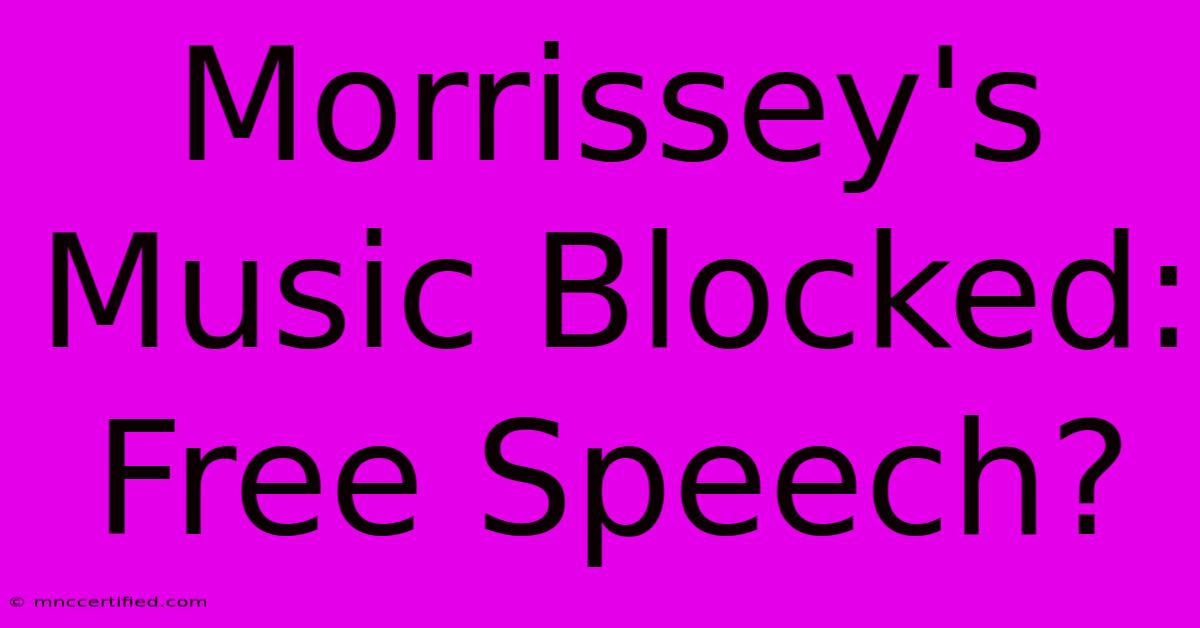Morrissey's Music Blocked: Free Speech?

Table of Contents
Morrissey's Music Blocked: A Free Speech Tightrope Walk?
The recent controversies surrounding Morrissey's music highlight a complex issue: where does artistic expression end and harmful speech begin? The removal of his music from certain platforms has sparked heated debate, forcing us to examine the delicate balance between free speech and the responsibility of content providers. This isn't just about Morrissey; it's about setting precedents for artistic freedom in the digital age.
The Controversies: A Timeline of Censorship Claims
Morrissey, throughout his career, has been known for his provocative lyrics and outspoken views. However, recent statements and interviews have pushed the boundaries, leading to accusations of promoting harmful ideologies. This isn't a new phenomenon; he's faced criticism for years. But the cumulative effect of these pronouncements, coupled with the increasing sensitivity surrounding hate speech online, has resulted in unprecedented action against his music.
Several platforms, facing pressure from activists and public outcry, have taken steps to limit the accessibility of his music. This includes removing his music from playlists, reducing its visibility in search results, and, in some extreme cases, completely removing it from their services. These actions haven't been met without resistance, with many arguing that this constitutes censorship and violates Morrissey's right to free speech.
The Free Speech Argument: A Double-Edged Sword
The First Amendment (in the US) and equivalent rights in other countries protect free speech, but this protection isn't absolute. It doesn't shield individuals from the consequences of their words, particularly when those words incite violence, promote discrimination, or constitute hate speech.
Morrissey's supporters argue that blocking his music sets a dangerous precedent, effectively silencing dissenting voices and chilling artistic expression. They contend that even controversial opinions, however unpopular, deserve to be heard, allowing for open dialogue and critical examination. This argument hinges on the idea that censorship leads to a slippery slope, ultimately suppressing all forms of non-conformist expression.
The Counterargument: Responsibility and Harm
Conversely, those who support the removal of Morrissey's music emphasize the potential harm his statements could cause. They argue that platforms have a responsibility to protect their users from hate speech and harmful content, even if it means limiting the reach of controversial artists. The argument focuses on the impact of his words, suggesting that the potential for harm outweighs the importance of preserving his platform. This view is underpinned by the idea that platforms are not obligated to provide a stage for hate speech, even if it's wrapped in the guise of artistic expression.
Navigating the Gray Areas: Finding a Balance
The Morrissey situation throws into sharp relief the complexities of balancing free speech with the need to combat harmful content online. There's no easy answer, and any solution will likely involve a nuanced approach that considers several factors:
- Context: The context in which statements are made is crucial. Is it satire, opinion, or incitement to violence?
- Intent: Was the intent to harm or discriminate, or was it simply provocative expression?
- Impact: What is the potential real-world impact of the statement on vulnerable groups?
Platforms are grappling with these questions, often struggling to establish clear and consistent guidelines for content moderation. This lack of clarity leads to inconsistencies in enforcement and fuels ongoing debates about censorship.
The Future of Artistic Expression Online
The ongoing controversy surrounding Morrissey’s music underscores the urgent need for a more robust and transparent discussion about content moderation policies online. We need to develop a framework that respects free speech while protecting vulnerable groups from harm. This requires a collaborative effort between platforms, artists, and policymakers to establish clear guidelines and mechanisms for appealing decisions regarding content removal. The ultimate goal is to foster an environment where diverse voices can be heard while preventing the spread of hate speech and harmful ideologies. The debate surrounding Morrissey's music serves as a vital case study in this ongoing struggle to find a balance.

Thank you for visiting our website wich cover about Morrissey's Music Blocked: Free Speech?. We hope the information provided has been useful to you. Feel free to contact us if you have any questions or need further assistance. See you next time and dont miss to bookmark.
Featured Posts
-
Gap Year Tragedy Methanol Deaths In Laos
Nov 21, 2024
-
Malpractice Insurance In Florida
Nov 21, 2024
-
Jaguars New Brand Mixed Reactions
Nov 21, 2024
-
Cheap Car Insurance Jonesboro Ar
Nov 21, 2024
-
Westbrooks Lame Call Nba Fans React
Nov 21, 2024